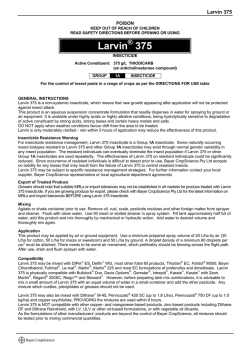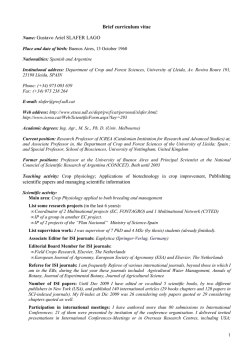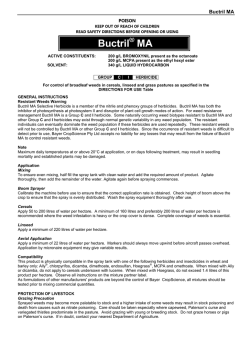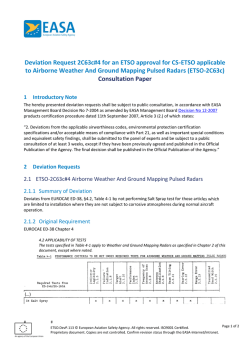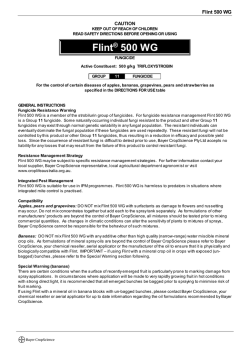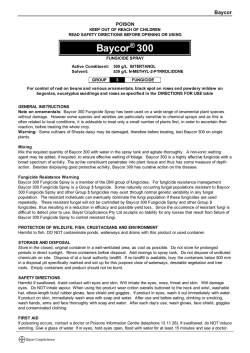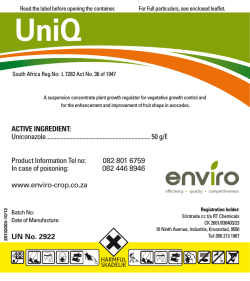
Confidor 200 SC Insecticide
Confidor 200 SC CAUTION KEEP OUT OF REACH OF CHILDREN READ SAFETY DIRECTIONS BEFORE OPENING OR USING Confidor® 200 SC INSECTICIDE Active Constituent: 200 g/L IMIDACLOPRID GROUP 4A INSECTICIDE For the control of various insect pests of cotton, fruit, vegetables and ornamentals as specified in the DIRECTIONS FOR USE table GENERAL INSTRUCTIONS Insecticide Resistance Warning For insecticide resistance management, Confidor is a Group 4A insecticide. Some naturally occurring insect biotypes resistant to Confidor and other Group 4A insecticides may exist through normal genetic variability in any insect population. The resistant individuals can eventually dominate the insect population if Confidor and other Group 4A insecticides are used repeatedly. The effectiveness of Confidor on resistant individuals could be significantly reduced. Since occurrence of resistant individuals is difficult to detect prior to use, Bayer CropScience accepts no liability for any losses that may result from the failure of Confidor to control resistant insects. Confidor may be subject to specific resistance management strategies. For further information contact your local supplier, Bayer CropScience representative or local agricultural department agronomist. Resistance Management Strategies Cotton aphid in cotton Observe the cotton industry Insecticide Resistance Management Strategy (IRMS). Aphids, whitefly and melon thrips in various crops (foliar sprays) Do not apply Confidor (or other group 4A insecticides) in consecutive sprays within and between seasons. Rotate with registered insecticides from other mode of action groups. Confined environments such as glasshouses: Annuals - Do not apply more than one spray of Confidor (or other group 4A insecticides) to any one crop. Perennials - Rotate with registered insecticides from other groups. Use a maximum of three Confidor (or other group 4A insecticides) sprays in any 12 month period. Brassica and lettuce (seedling drench applications) DO NOT apply Confidor 200 SC or any other Group 4A Insecticide following a seedling drench application of Confidor 200 SC or any Group 4A Insecticide in that crop. Mixing Prior to pouring, shake container vigorously, then add the required quantity of Confidor 200 SC to water in the spray vat while stirring or with agitators in motion. Application Foliar Spray Application Where rates are expressed in mL/100 L mix specified rates of product per 100 L water and spray plants to “point of runoff” stage, thoroughly covering all plant surfaces. Where rates are expressed in mL/ha apply specified rates per hectare using appropriate spray equipment and sufficient water to provide adequate penetration and coverage. Aim to apply even small droplet coverage over all plant surfaces. Equipment settings and water volume may need to vary, depending on the growth stage of the crop. Special Instructions for Cotton Thorough coverage of cotton plants is essential to achieve maximum performance from Confidor plus Pulse. Equipment should be calibrated to achieve a minimum of 60 droplets/cm2 on the target foliage. A droplet Volume Median Diameter (VMD) for optimum performance from Confidor plus Pulse is dependent on equipment and is defined below. Do not apply when unfavourable environmental conditions may reduce the quality of spray coverage. Ground Application (Cotton) Application using ground equipment should be made using hollow cone nozzles with a minimum spray volume of 100 L/ha. Hollow cone nozzles are recommended but if flat fan nozzles are used, higher water volumes will be required and nozzles should be configured to ensure thorough coverage. A droplet VMD of 150 - 180 microns must be used. Where multiple nozzles per row are used, they should be of the same specification to ensure that each nozzle contributes an equal proportion of the required dose. Where multiple nozzles per row are used (particularly for banded applications) ensure the correct nozzle overlap pattern is achieved on the target foliage. Banded applications less than 100% are not recommended beyond the 15 node crop stage. Confidor 200 SC Aerial Application (Cotton) Apply in a minimum spray volume of 25 L/ha. A droplet VMD of 120 - 150 microns must be used. Do not exaggerate swath width or exceed a swath width of 20 to 22 m. Do not apply Confidor plus Pulse using Ultra Low Volume (ULV) methods. The use of large droplet placement equipment is not recommended. Special Instructions for Stone Fruit Dilute Spraying ♦ Use a sprayer designed to apply high volumes of water up to the point of run-off and matched to the crop being sprayed. ♦ Set up and operate the sprayer to achieve even coverage throughout the crop canopy. Apply sufficient water to cover the crop to the point of run-off. Avoid excessive run-off. ♦ The required water volume may be determined by applying different test volumes, using different settings on the sprayer, from industry guidelines or expert advice. ♦ Add the amount of product specified in the Directions for Use table for each 100 L of water. Spray to the point of run-off. ♦ The required dilute spray volume will change and the sprayer set up and operation may also need to be changed, as the crop grows. Concentrate Spraying ♦ Use a sprayer designed and set up for concentrate spraying (that is a sprayer which applies water volumes less than those required to reach the point of run-off) and matched to the crop being sprayed. ♦ Set up and operate the sprayer to achieve even coverage throughout the crop canopy using your chosen water volume. ♦ Determine an appropriate dilute spray volume (See Dilute Spraying above) for the crop canopy. This is needed to calculate the concentrate mixing rate. ♦ The mixing rate for concentrate spraying can then be calculated in the following way: EXAMPLE ONLY 1. Dilute spray volume as determined above: For example 1500 L/ha 2. Your chosen concentrate spray volume: For example 500 L/ha 3. The concentration factor in this example is: 3 X (ie 1500 L ÷ 500 L = 3) 4. As the dilute label rate is 25 mL/100 L for stone fruit, then the concentrate rate becomes 3 x 25, that is 75 mL/100 L of concentrate spray. ♦ The chosen spray volume, amount of product per 100 L of water, and the sprayer set up and operation may need to be changed as the crop grows. ♦ Do not use a concentrate rate higher than that specified in the Critical Comments. ♦ For further information on concentrate spraying, users are advised to consult relevant industry guidelines, undertake appropriate competency training and follow industry Best Practices. Seedling drench application (brassicas and lettuce) Ensure even application Deliver the target rate of Confidor to seedling trays, ensuring uniform distribution of Confidor to each transplant cell. This may be achieved by a single (full rate) or consecutive, multiple (part rate) passes of the application mechanism. Confidor should be applied through dedicated nursery equipment e.g. a hydraulic boom or other suitable equipment which has been carefully set up and calibrated to ensure uniform distribution. DO NOT use watering cans, hand wands, impact sprinklers and other imprecise means of application. Avoid run-through from cells Applied spray volume must be related to the cell media moisture content and cell capacity, to ensure that there is virtually no loss of applied spray as run-through from cell trays during or following the Confidor application. Prevent spray drift from treatment area Spray application should be in an enclosed area, or for example, with an adequately shrouded spray boom, to ensure there is no opportunity for spray drift from the treatment site. Minimise and capture excess spray The quantity of excess spray, i.e. applied spray mixture which is not confined in the cell medium, must be minimised by appropriate application equipment set-up. Excess spray includes applied spray which misses the target, runs-off or inadvertently runs-through the cells. Any such excess must be captured and should be filtered and returned to the spray tank or stored for collection by a licensed waste treatment service provider. Avoid losses from watering after treatment Avoid watering seedlings after application. If watering is necessary it must be done sparingly. DO NOT allow runthrough from the cells. Schedule treatment to minimise time interval to planting Seedling damage may result from Confidor seedling drench treatment, particularly if transplanting does not occur soon after treatment. It is recommended that transplanting occur within 24 hours of treatment, therefore application should be scheduled accordingly, close to the time of seedling dispatch. Confidor 200 SC Compatibility Confidor 200 SC is compatible with Antracol®, Baycor®, Nitofol®. Do not mix concentrates together but add each to the spray tank separately. As formulations of other manufacturers' products are beyond the control of Bayer CropScience, all mixtures should be tested prior to mixing commercial quantities. As changes in climatic conditions can alter the sensitivity of plants to mixtures of sprays, Bayer CropScience cannot be responsible for the behaviour of such mixtures. Export of Treated Produce Growers should note that MRLs or import tolerances do not exist in all markets for edible produce treated with Confidor. If you are growing edible produce for export, please check with Bayer CropScience for the latest information on MRLs and import tolerances before using Confidor. Note on Ornamentals Confidor 200 SC Insecticide has been used on a wide range of ornamental plant species without damage. However, some species and varieties are particularly sensitive to chemical sprays and as this is often related to local conditions it is advisable to treat only a small number of plants first, in order to ascertain their reaction before treating the whole crop. PRECAUTIONS Seedling drench application: At the nursery - gloves should be worn when handling treated seedling trays or seedlings. Cotton overalls buttoned to the neck and wrist (or equivalent clothing) should also be worn, particularly if seedlings and/or trays are still wet following treatment. On farm including during planting - gloves should be worn when handling treated seedling trays or seedlings. PROTECTION OF LIVESTOCK Dangerous to bees. DO NOT spray any plants in flower if bees may forage on treated flowers. DO NOT graze any treated area, or cut for stock food. DO NOT feed produce harvested from treated area to animals, including poultry. PROTECTION OF WILDLIFE, FISH, CRUSTACEANS AND ENVIRONMENT DO NOT contaminate streams, rivers or waterways with the chemical or used containers. Imidacloprid is toxic to certain aquatic species. Aerial application: A spraydrift minimisation strategy should be employed at all times when aerially applying sprays. The strategy envisaged is exemplified by the cotton industry's Best Management Practices Manual. Seedling drench application: DO NOT allow run-off from treatment areas to enter drains and waterways. STORAGE AND DISPOSAL Store in the closed, original container in a cool, well ventilated area. Do not store for prolonged periods in direct sunlight. 1 litre pack Triple or preferably pressure rinse containers before disposal. Add rinsings to spray tank. DO NOT dispose of undiluted chemicals on-site. Dispose of container at an approved waste management facility. If an approved facility is not available bury the empty packaging 500 mm below the surface in a disposal pit specifically marked and set up for this purpose clear of waterways, desirable vegetation and tree roots, in compliance with relevant Local, State or Territory government regulations. Empty containers and product must not be burnt. Do not re-use empty container for any other purpose. 10 litre pack Triple or preferably pressure rinse containers before disposal. Add rinsings to spray tank. DO NOT dispose of undiluted chemicals on site. If recycling, replace cap and return clean containers to recycler or designated collection point. If not recycling, triple rinse, break, crush or puncture and deliver empty packaging for appropriate disposal at an approved waste management facility. If an approved waste management facility is not available bury the empty packaging 500 mm below the surface in a disposal pit specifically marked and set up for this purpose clear of waterways, desirable vegetation and tree roots, in compliance with relevant Local, State or Territory government regulations. Empty containers and product must not be burnt. Do not re-use empty container for any other purpose. SAFETY DIRECTIONS Harmful if swallowed. May irritate the eyes and skin. Repeated exposure may cause allergic disorders. Avoid contact with eyes and skin. When preparing product for use, wear cotton overalls buttoned to the neck and wrist (or equivalent clothing), a washable hat, elbow-length chemical resistant gloves and goggles. Wash hands after use. After each day's use, wash gloves, goggles and contaminated clothing. FIRST AID If poisoning occurs contact a doctor or Poisons Information Centre (telephone 13 11 26). MATERIAL SAFETY DATA SHEET Additional information is listed in the Material Safety Data Sheet, which can be obtained from www.bayercropscience.com.au. Confidor 200 SC EXCLUSION OF LIABILITY This product must be used strictly as directed, and in accordance with all instructions appearing on the label and in other reference material. So far as it is lawfully able to do so, Bayer CropScience Pty Ltd accepts no liability or responsibility for loss or damage arising from failure to follow such directions and instructions. APVMA Approval No.: 50548/50935 ® ® ® FOR 24 HOUR SPECIALIST ADVICE IN EMERGENCY ONLY PHONE 1800 033 111 ® Confidor , Antracol , Baycor and Nitofol are Registered Trademarks of Bayer DIRECTIONS FOR USE FOLIAR SPRAY APPLICATIONS CROP Cotton PEST Aphids RATE 250 mL/ha + Pulse Penetrant at 0.2% v/v (2 mL/L water) or equivalent organosilicone surfactant* (eg Freeway Gold) WHP 13 weeks * Check with Bayer CropScience for recommended organosilicone surfactants Stone fruit Cucurbits Capsicum, eggplant potato Tomato Brassicas Sweet potato Cucumber Eggplant Mirids, brown flea beetle Green peach aphid, black peach aphid Green peach aphid Grey cabbage aphid, turnip aphid Silverleaf whitefly, including type B Melon thrips Dilute spraying 25 mL/100 L Concentrate spraying Refer to the Application section 21 days 25 mL/100 L or 300 mL/ha 1 day 7 days 3 days 7 days 25 mL/100 L or 250 mL/ha 7 days 1 day 7 days CRITICAL COMMENTS The addition of Pulse Penetrant or equivalent is critical for the performance of Confidor. Apply early in the establishment of an aphid infestation when numbers are low (ie no more than 1 or 2 leaves per plant with honeydew present). Applications made later than this may result in reduced control. Shorter residual control may be evident and a repeat application of a registered aphicide (follow the Cotton Insecticide Resistance Management Strategy for cotton aphid) may be required to achieve complete control: • if applications of Confidor plus Pulse or equivalent are timed too late (see above); or • if existing high density aphid colonies (hotspots) are present; or • if aphids have established throughout the plant canopy (especially lower in the canopy); or • if there is high reinfestation pressure; or • if there is rapid crop growth; or • if Confidor plus Pulse or equivalent is used following a spray-failure (eg resistance to organophosphate or carbamate insecticides). Note: Where resistance to carbamates or organophosphates is suspected, Confidor plus Pulse or equivalent should be used first so as not to delay control of the aphids present. Aphids treated with Confidor plus Pulse or equivalent may still be present on the plant but will not be feeding. Control of aphids should initially be assessed by a reduction in fresh honeydew and not on the presence of aphids on the plant. After ingesting Confidor, aphids may take up to 5 days to die. Apply when pest numbers reach treatment threshold levels as determined by field checks. Apply at first sign of aphid infestation. Apply as a full cover spray, ensuring thorough coverage. Apply by dilute or concentrate spraying equipment. Apply the same total amount of product to the target crop whether applying this product by dilute or concentrate spraying methods. Do not use in equipment that requires rates greater than 125 mL/100 L of water (i.e. greater than 5 X concentrate). Apply at first sign of aphid infestation. Apply at first sign of aphid infestation. Add a wetting agent. Apply at first sign of whitefly or melon thrips infestation. Apply dilute sprays (25 mL/100 L) to run off. Ensure thorough coverage of underside of leaves. Use of droppers will improve coverage of underside of leaves. Confidor 200 SC FOLIAR SPRAY APPLICATIONS (continued) CROP Roses Ornamental plants PEST Aphids Aphids, azalea lace bug, bronze orange bug, citrus mealybug, Fullers rose weevil, greenhouse thrips, harlequin bug, silverleaf whitefly (suppression) Hibiscus flower beetle Longtailed mealybug RATE 25 mL/100 L Psyllids Soft scales 50 mL/100 L 50 mL/100 L + surfactant 25 mL/100 L 25 mL/100 L Duboisia Green peach aphid 25 mL/100 L Pandanus trees Flatid (Jamella australiae) Spot spray 875 mL/100 L of water Stem injection 1.75 L/1 L of water WHP _ CRITICAL COMMENTS Apply as a thorough cover spray at first sign of insect infestation. Spray buds and flowers as needed. Apply 3 sprays 2 weeks apart. Use a non-ionic surfactant at label rate. Spray at first sign and then a week later. Spray in late spring or when small scales are first seen. Apply 3 sprays 2 weeks apart. Add a wetting agent. Apply when aphid numbers reach spray threshold levels as determined by regular monitoring. Ensure thorough coverage of all leaves. Spot spray: Spray 100 mL of mixture directly into the leafy throat of each head. Stem injection: Drill holes 0.5 to 1 cm in diameter and 10 cm deep at an angle of 30° 1 to 1.5 m above ground level. Drill one hole per limb (or trunk in single trunked trees). Apply 5 mL of mixture in each hole and seal the hole. Do not reapply in the same holes. Uptake of Confidor, and therefore control of the pest in heavily infested heads already showing severe damage, will be slow and may be incomplete. SOIL APPLICATIONS CROP Apples PEST Woolly aphid RATE Chemical control 6 mL/1 L of water/tree Beneficial insect plus chemical control (eg Aphelinus mali plus Confidor) 3 mL/1 L of water/tree 3.5 mL/250 mL water/pot WHP - CRITICAL COMMENTS For trees up to 7 years of age. During late summer or autumn, apple trees with woolly aphid colonies or damage should be identified and marked for treatment the following season. At green tip to petal fall, apply 1 litre of the prepared Confidor mixture to moist soil immediately around the base of the tree trunk. Ensure the mixture infiltrates the soil around the trunk and does not run off the soil. Control weeds before application. Do not disturb or remove the soil around the trunk during the season. If aerial colonies are present at application, maximum effectiveness may not be achieved until the following season. Do not treat more than once in any 2 year period. Azaleas in pots Azalea lace bug - Use as a soil drench for pots up to 20 L capacity. Prior to application remove mulch and dead vegetation, and moisten the soil surface. Apply the Confidor mixture, and then water it in well immediately after application. Mix the required dose in sufficient water to adequately treat each tree. Use at least 50 L of mix per tree up to a tree diameter of 400500 mm and then 100 L per tree for larger trees. Inject mix to a depth of 20-30 cm in a minimum of 4 injection sites per tree, 0.75 to 1.5 m apart, arranged in an evenly spaced grid to just beyond the drip line. Ensure root zone is adequately moist with active root growth. Keep treated area moist for 7-10 days after treatment. Treat at least 6-10 weeks prior to pest attack in late winter or early spring when roots are active. DO NOT treat if soil is waterlogged. Use as a soil drench. 5 L of mixture will treat twenty 6 L pots. Prior to application remove mulch and dead vegetation, and moisten the soil surface. Apply the Confidor mixture, and then water it in well immediately after application. Use as a soil drench by pouring mixture evenly around drip zone. Use this rate for plants up to 1 m high. For each additional metre of plant height, add 2 mL extra of Confidor to the 2 L of water. Prior to application remove mulch and dead vegetation, and moisten the soil surface. Apply the Confidor mixture, and then water it in well immediately after application. Elm Elm leaf beetle 7 mL/25 mm of tree diameter at breast height - Ornamentals in pots Scarab beetle larvae 3.5 mL/5 L water - Roses Aphids 3.5 mL/2 L water/plant - Confidor 200 SC SEEDLING DRENCH APPLICATIONS Restraint: DO NOT transplant seedlings treated by seedling drench into hydroponic production systems. CROP Brassicas (broccoli, Brussels sprouts, cabbage, cauliflower, kohlrabi) Lettuce (head lettuce) Lettuce (excluding head lettuce), chicory, endive, radicchio PEST Silverleaf whitefly, including type B RATE Seedling drench 40 mL/1000 seedlings Green peach aphid, onion thrips Seedling drench 20-40 mL/1000 seedlings Currantlettuce aphid Planting densities up to 70,000 plants/ha 35-55 mL/1000 seedlings applied as a seedling drench Planting densities from 70,000 to 110,000 plants/ha 12.5-35 mL/1000 seedlings applied as a seedling drench Planting densities from 110,000 to 150,000 plants/ha 12.5-25 mL/1000 seedlings applied as a seedling drench Planting densities from 150,000 to 300,000 plants/ha 12.5 mL/1000 seedlings applied as a seedling drench WHP - CRITICAL COMMENTS BRASSICAS ONLY Green peach aphid, onion thrips: When Confidor is used for the control of silverleaf whitefly, including type B, control of green peach aphid and onion thrips will also be achieved. Seedling drench (prior to transplanting) Apply to the transplant cell, once only, prior to transplanting. 6 weeks For applications specifically against green peach aphid and onion thrips, select the rate taking into account the likely crop type, crop growing period, the anticipated degree of pest infestation and previous field experience (e.g. consideration of crop variety, time of year, predator activity, soil type). Refer to Additional Critical Comments – all crops below for further advice. 4 weeks LETTUCE, CHICORY, ENDIVE, RADICCHIO ONLY Seedling drench (prior to transplanting) Apply to the transplant cell, once only, prior to transplanting. The maximum recommended application rate per 1000 seedlings will depend on the proposed field planting density, as shown in the RATE column. Planting densities up to 70,000 plants per hectare In the RATE column, identify the desired planting density and the corresponding recommended rate range. Select the rate taking into account the likely crop growing period, the anticipated degree of pest infestation and previous field experience (e.g. consideration of lettuce type, variety, time of year, predator activity, soil type). The lower rate will usually be adequate for crops with a short growing period (e.g. less than 6-7 weeks), while the higher rate will be necessary for most situations where conditions are highly favourable for aphid infestation and for longer crop growing periods (e.g. greater than 6-7 weeks). The lower rate may also be appropriate where control from the Confidor application is not required for the entire crop growing period and where insecticides with alternative modes of action will be used as part of a broader lettuce aphid management strategy during latter stages of crop development. Refer to Additional Critical Comments – all crops below for further advice. Planting densities from 70,000 to 110,000 and 110,000 to 150,000 plants per hectare In the RATE column, identify the desired planting density and the corresponding recommended rate range. Select the rate taking into account the likely crop growing period, the anticipated degree of pest infestation and previous field experience (e.g. consideration of lettuce type, variety, time of year, predator activity, soil type). The lower rate will be suitable where a short duration of control is required, while a higher rate will generally provide an increased length of control. Critical Comments continued next page Confidor 200 SC CROP PEST Continued from previous page RATE WHP CRITICAL COMMENTS Continued However these rates may not provide control of currant lettuce aphid for the entire crop growing period. Monitor crops and if required use insecticides with alternative modes of action as part of a broader lettuce aphid management strategy during latter stages of crop development. Refer to Additional Critical Comments – all crops below for further advice. Planting densities from 150,000 up to 300,000 plants per hectare In the RATE column, identify the desired planting density and the corresponding recommended rate. This rate may not provide control of currant lettuce aphid for the entire crop growing period. Monitor crops and if required use insecticides with alternative modes of action as part of a broader lettuce aphid management strategy during latter stages of crop development. Refer to Additional Critical Comments – all crops below for further advice. Additional Critical Comments – all crops Confidor provides effective management of pest populations. However, Confidor may not provide complete control of pests for the entire growing period in all situations. Crops should be monitored for pests following transplanting and throughout the life of the crop. If pests are observed in the crop additional chemical control may be required, in which case an insecticide with a different mode of action should be used. Refer to GENERAL INSTRUCTIONS for Resistance Management Strategy information. Refer to GENERAL INSTRUCTIONS for Seedling Drench Application directions and PRECAUTIONS when handling treated seedlings. Seedling damage may result from Confidor seedling drench treatment particularly if transplanting does not occur soon after treatment. It is recommended that transplanting occur within 24 hours of treatment and that planted seedlings receive sufficient irrigation (preferably using overhead sprinklers) as soon as possible after transplanting to further minimise the risk of seedling damage. This may be particularly relevant under conditions of rapid drying of the transplant cell medium. If watering is required between applications and planting, it should be done sparingly, only as required. DO NOT allow run-through from the cells. When transplanting treated seedlings ensure that the growing medium is fully transferred to the field with each seedling. Seedling production nurseries supplying Confidor treated seedlings must ensure that; a) Supplied batches of seedlings are clearly identified as having been treated with Confidor 200 SC Insecticide. b) Paperwork accompanying the seedlings and provided to the recipient indicates the rate of Confidor applied per 1000 seedlings, and the time and date of treatment. c) Growers accepting delivery of treated seedlings have obtained a copy of Confidor 200 SC seedling drench – instructions for growers, available from Bayer CropScience (1800 804 479 or www.bayercropscience.com.au) NOT TO BE USED FOR ANY PURPOSE, OR IN ANY MANNER, CONTRARY TO THIS LABEL UNLESS AUTHORISED UNDER APPROPRIATE LEGISLATION Confidor 200 SC WITHHOLDING PERIODS Foliar spray applications Harvest: Cucurbits: DO NOT HARVEST FOR 1 DAY AFTER APPLICATION Tomatoes: DO NOT HARVEST FOR 3 DAYS AFTER APPLICATION Brassicas, capsicum, eggplant, potatoes, sweet potatoes: DO NOT HARVEST FOR 7 DAYS AFTER APPLICATION Stone fruit: DO NOT HARVEST FOR 21 DAYS AFTER APPLICATION Cotton: DO NOT HARVEST FOR 13 WEEKS AFTER APPLICATION Soil or seedling drench applications Harvest: Apples: NOT REQUIRED WHEN USED AS DIRECTED Brassicas: NOT REQUIRED WHEN USED AS DIRECTED Chicory, endive, lettuce (excluding head lettuce) and radicchio: DO NOT HARVEST FOR 4 WEEKS AFTER APPLICATION Head lettuce: DO NOT HARVEST FOR 6 WEEKS AFTER APPLICATION All applications Grazing: DO NOT GRAZE ANY TREATED AREA, OR CUT FOR STOCK FOOD. DO NOT FEED PRODUCE HARVESTED FROM TREATED AREA TO ANIMALS, INCLUDING POULTRY.
© Copyright 2024
